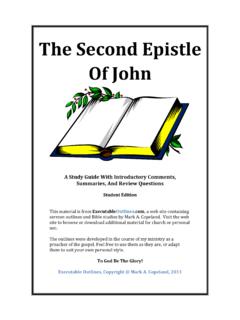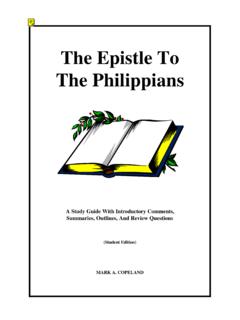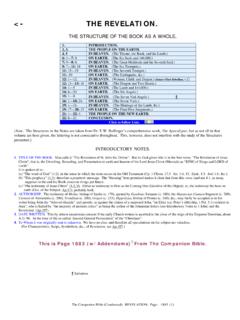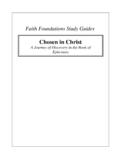Transcription of Dating Revelation: Another Perspective - Charles …
1 Dating revelation : Another Perspective by Don K. Preston A prominent writer and preacher has recently written an article on the date of the Apocalypse in which he advocates the "traditional" late date, ie 95 AD. He sets forth his defense of same as an objection to the "bizarre theories that have surfaced in recent times [ the notion that all 'end time'prophecies were fulfilled with the fall of Jerusalem in 70."] We would observe that there are a host of scholars and students that advocate the early date of revelation who do not hold to these "bizarre theories." We believe this writer has done as good a job as possible to uphold the late date of revelation , but we believe the evidence will not support his thesis. We are convinced revelation was written as a prophecy of the fall of Jerusalem in 70 Surely, an examination of all the evidence is necessary to any honest inquiry into truth. Our purpose here is to examine the evidence presented by the above mentioned writer and show the fallacy of the late date for revelation .
2 External Evidence Our friend cites five external sources as supportive of a late [94-96 ], date for revelation . One, Eusebius, is admittedly dependent upon Irenaeus for his information. [1] This means our friend really has only four "independent" sources. Irenaeus, second generation from John the Apostle, maintained that John saw the revelation late in Domitian's reign. As Daniel Denham states, "The testimony of Irenaeus is considered the bastion of the evidence for the Late Date." [2] But Denham admits some problems with this "bastion of evidence." First, the Greek language of Irenaeus can be understood to refer not to the revelation , but to John being seen on Patmos. Second, he observes it is possible that Irenaeus has been misunderstood. Robert Young stated that the name Domitianou, referring actually to Nero, was mistaken by later writers for Domitian. Denham, although a late date advocate, is therefore forced to admit, "The obscurity of the testimony, as it has come down to us, must be considered as weak and inconclusive to demand the Late Date.
3 " [3] Clement of Alexandria says John returned from Patmos after being exiled there by "the tyrant;" and citing Eusebius, the author under review says the tyrant is undoubtedly Domitian. The trouble is, Eusebius is far removed from the historical and chronological context of the Apocalypse! Eusebius wrote in approximately 324. But we have much earlier testimony as to the identity of "the tyrant.". Gary Gentry, [4], cites Tacitus, Suetonius, Pliny the Elder, the Roman satirist Juvenal, and others, all of whom predate Eusebius as calling Nero the tyrant. Miriam Griffin, [5], calls Nero "the proverbial tyrant.". Our brother also notes that Clement calls John an "old man" when released from Patmos and says this would not apply if said when he was only in his sixties, [prior to 70 ]. But Paul the apostle called himself Paul the aged, Philemon verse 9, and he was only about 60 years old! [6] Further, our late date advocate fails to inform the reader of the problems associated with accepting Clement's testimony and also fails to note a serious contradiction in his other writings.
4 Had John returned from Patmos at age 90+, [in ], consider: Clement claims John went into the wilderness on horseback and chased down a former convert turned criminal, physically capturing him, and taught him once again the truth! [7] Could John do this at age 90+; the age he would have been if revelation was written in 94-95? Why did our brother not inform his readers that Clement maintained that all divine revelation ceased in the time of Nero?!? Clement definitely believed John wrote the Apocalypse. But "How could he have made this statement if John's revelation had been written about thirty years after Nero?" If late date advocates are going to accept the external testimony of Clement, they are faced with a genuine dilemma here. Victorinus and Jerome constitute the remainder of our brother's external evidence. But note that Victorinus wrote in the late 3rd and Jerome in the early 4th century. Their testimony is therefore somewhat late. Not to mention they both seem to be dependent on Irenaeus.
5 In addition, Victorinus in his citation, insists that John was working in the mines of Patmos when exiled there. How could this be the case if John was well into his nineties? [9] One should be very cautious then, in maintaining the strength of the external testimony in regard to the date of the Apocalypse. The testimony is at best debatable, scant and interdependent. Further, external evidence cannot militate against the internal evidence especially when thatexternal testimony is subject to serious objection. Internal Evidence Our friend contends that the spiritual conditions of the churches mentioned in revelation favor a late date. We believe the evidence indicates otherwise. He says the fact the church at Ephesus had left its first love demands more time than demanded between the complimentary letter of Ephesians, approximately 61, and the early date, 67-69. But it certainly was not long between the establishment of the Galatian churches and their "so soon" removal from the faith, Galatians 1:6-7.
6 Further, Paul warned the Ephesian elders of impending trouble in Acts 20 and in I Timothy [ ] he tells the young evangelist how to cope with the false teachers which abounded in Ephesus at the very time. It is insisted that since Laodicea was destroyed by earthquake in 60 it would have taken more than the eight or nine years to recover between the earthquake and reconstruction. But the historian Tacitus [10] reports that the city was so wealthy that they rebuilt their city "without any subvention from Rome.". It is suggested that the "full-fledged sect" of the Nicolaitans, revelation 2:6,15 demands a late date since these groups are only "hinted at" in 2 Peter and Jude. But the reader is urged to read 2 Peter and Jude for yourself. Peter writes an entire chapter, and Jude's entire letter is written to combat the then present reality of those heresies! That is a little more than a "hint"! Nero's persecution was limited to the city of Rome, we are told, but the seven letters suggest a wide spread persecution more in keeping with a later date.
7 It is only assumed Nero's persecution was confined to Rome, however. Emminent historian William Ramsey, [11] well notes "When Nero had once established the principle [of persecution, DKP] in Rome, his action served as precedent in every province.". Our friend would say the persecution in revelation agrees better with that of Domitian than of Nero. Yet modern scholarship is becoming skeptical about the reality of any systematic or prolonged persecution instigated by Domitian. Leon Morris [12(1)], says "While later Christians sometimes speak of a persecution under Domitian the evidence is not easy to find." George Ladd says "there is no evidence that during the last decade of the first century there occurred any open and systematic persecution of the church." [12(2)]. Arguments Against Early Date We come then to consider some of our brother's responses to early date arguments. He notes the contention that it would be strange indeed for this book to be written after Jerusalem's demise and contain no mention of the catastrophe.
8 He responds by saying "some scholars see a veiled reference to Jerusalem's destruction in 11:8 where the 'great city,' in which the Savior was crucified [Jerusalem] is called Sodom-- not merely because of wickedness, but due to the fact that it was a DESTROYED city." But in chapter 11 the city under consideration [Jerusalem, by our friend's own admission] had patently not been destroyed! See revelation 11:11-14. John was not looking back; he was anticipating "things which must shortly come to pass!" See chapter 1:1-3. Further, if this reference to Jerusalem is "post facto" then the appearance of the two witnesses was as well;. but in verses 3ff we are told clearly that the witnesses had not yet come! He says the insistence that "the literal city and temple were still standing, based on chapter 11, ignores the express symbolic nature of the narrative." At first blush this sounds convincing but he has contradicted himself. He has already acknowledged that "where our Lord was crucified" is advert to literal Jerusalem.
9 Now he wants to deny this. The fact is, chapter 11 is symbolic. Yet in the midst of the symbology we find the interpretive phrase "where our Lord was crucified" to clear away the confusion. "Where our Lord was crucified" is not symbolic, it is interpretive! Our friend cites, with approval, Salmon who expresses amazement that anyone could see a reference to literal Jerusalem since "the whole scene is laid in heaven." Carried to its logical extension this means Jesus was crucified in heaven! The witnesses, symbolic we are certain, were to be killed in the same city where Jesus was crucified. But if this was all only going to happen in heaven then Jesus must have died in heaven! Our studied brother says we have only to compare Ezekiel's vision and measuring of the temple to realize that [John's] Jerusalem could in fact have been already destroyed. Ezekiel was told to measure the temple, Ezekiel 40, but our brother observes the literal temple had been destroyed some 14 years earlier.
10 The suggested analogy is that John was to measure the temple that had already been destroyed. But Ezekiel was measuring a FUTURE temple, not the one destroyed earlier. And John was told to measure a temple that was about to be destroyed, 11:1-2. One might also ask why John is being asked to measure a temple that was destroyed some 25 years earlier since in our brother's words "there would be little need to focus upon the destruction of Jerusalem since the lessons of that catastrophe would have been well learned in the preceding quarter century."? The Bible sometimes spoke of future events in the past tense, Isaiah 46:9-10. But where does the Bible ever speak of past events in the future tense? Yet this is precisely what our brother demands in revelation 11 to avoid the obvious Jerusalem was still standing but was about to fall. He insists it is "the most irresponsible form of exegesis" to assert that Nero fulfills the enigmatic 666 of revelation 13:6.




